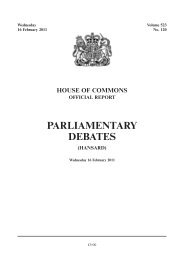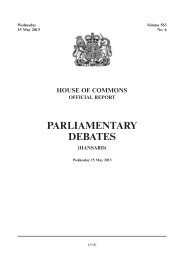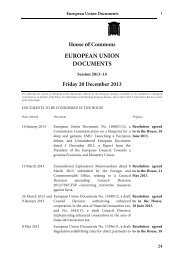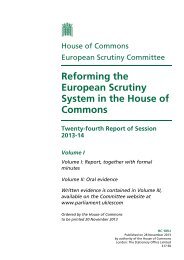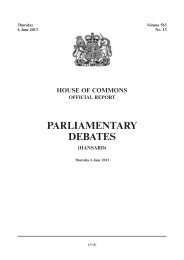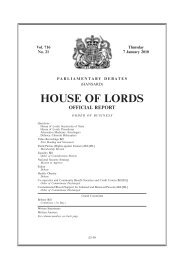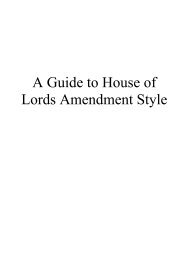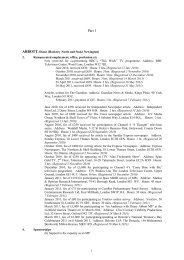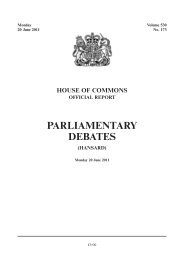View PDF - United Kingdom Parliament
View PDF - United Kingdom Parliament
View PDF - United Kingdom Parliament
You also want an ePaper? Increase the reach of your titles
YUMPU automatically turns print PDFs into web optimized ePapers that Google loves.
189W<br />
Written Answers<br />
26 OCTOBER 2009<br />
Written Answers<br />
190W<br />
Vetting<br />
Chris Huhne: To ask the Secretary of State for the<br />
Home Department what guidance his Department has<br />
issued to employers and employees in England and<br />
Wales seeking a basic disclosure check. [294256]<br />
Alan Johnson: Guidance from the Criminal Records<br />
Bureau advises individuals seeking a basic disclosure<br />
check to contact Disclosure Scotland.<br />
CHILDREN, SCHOOLS AND FAMILIES<br />
Children: Databases<br />
Tim Loughton: To ask the Secretary of State for<br />
Children, Schools and Families when he expects<br />
ContactPoint to be fully operational. [295514]<br />
Dawn Primarolo: ContactPoint is already operational.<br />
From late October, local authorities can start training<br />
ContactPoint users across England. The speed at which<br />
practitioner use of ContactPoint builds up over time<br />
will be agreed jointly with local authorities and national<br />
partners.<br />
Access to ContactPoint is strictly limited to those<br />
who need it as part of their work, and who have been<br />
security vetted and trained. Our latest evidence-based<br />
analysis suggests that the number of users will be 390,000.<br />
The ultimate number of users will be determined by<br />
local authorities and national partners. Those decisions<br />
will be governed by regulations and guidance and,<br />
ultimately, by capacity and resources.<br />
Children: Poverty<br />
Tim Farron: To ask the Secretary of State for<br />
Children, Schools and Families what estimate his<br />
Department has made of the number of children in<br />
rural areas living in poverty in each year since 1997.<br />
[293210]<br />
Helen Goodman: I have been asked to reply:<br />
Estimates of the number of children in rural areas<br />
living in poverty are derived from the Family Resources<br />
Survey produced by the Department for Work and<br />
Pensions. The survey is available on the Department’s<br />
website at<br />
http://research.dwp.gov.uk/asd/frs/2007_08/<br />
frs_2007_08_report.pdf<br />
A copy is also in the Library.<br />
Data on rurality are only available on the Family<br />
Resources Survey since 2004/05, so no information is<br />
available prior to 2004/05.<br />
The information that is available is given in the tables.<br />
Due to different definitions of rurality in Scotland<br />
compared to England and Wales, and the fact that no<br />
information is collected on the Family Resources Survey<br />
covering rurality in Northern Ireland, it has not been<br />
possible to present figures for the <strong>United</strong> <strong>Kingdom</strong> as a<br />
whole. This also means that the figures in table 4 are not<br />
comparable with figures presented in the other tables.<br />
Table 1: Number of children in rural areas in England in households with<br />
incomes below 60 per cent. of contemporary median income, 2004/05 to 2007/08,<br />
before and after housing costs<br />
Million<br />
Period Before housing costs After housing costs<br />
2004/05 0.3 0.4<br />
2005/06 0.3 0.4<br />
2006/07 0.3 0.4<br />
2007/08 0.3 0.5<br />
Table 2: Number of children in rural areas in Wales in households with incomes<br />
below 60 per cent. of contemporary median income, 2004/05 to 2006/07 and<br />
2005/06 to 2007/08, before and after housing costs<br />
Million<br />
Period Before housing costs After housing costs<br />
2004/05 to 2006/07 — 0.1<br />
2005/06 to 2007/08 0.1 0.1<br />
Table 3: Number of children in rural areas in England and Wales in households<br />
with incomes below 60 per cent. of contemporary median income, 2004/05 to<br />
2007/08, before and after housing costs<br />
Million<br />
Period Before housing costs After housing costs<br />
2004/05 0.3 0.4<br />
2005/06 0.3 0.5<br />
2006/07 0.4 0.5<br />
2007/08 0.3 0.5<br />
Table 4: Number of children in rural areas in Scotland in households with<br />
incomes below 60 per cent. of contemporary median income, 2004/05 to 2006/07<br />
and 2005/06 to 2007/08, before and after housing costs<br />
Million<br />
Period Before housing costs After housing costs<br />
2004/05 to 2006/07 — —<br />
2005/06 to 2007/08 — —<br />
Notes:<br />
1. These statistics are based on Households Below Average Income, sourced<br />
from the Family Resources Survey.<br />
2. Small changes should be treated with caution as these will be affected by<br />
sampling error and variability in non-response.<br />
3. The reference period for Households Below Average Income figures are single<br />
financial years. For Wales and Scotland, three years of data have had to be<br />
combined due to small sample size.<br />
4. A ‘—’ in the table indicates that the number of children in low income<br />
households is less than 50,000 in the period.<br />
5. The income measures used to derive the estimates shown employ the same<br />
methodology as the Department for Work and Pensions publication “Households<br />
Below Average Income”’ (HBAI) series, which uses disposable household<br />
income, adjusted (or ‘equivalised’) for household size and composition, as an<br />
income measure as a proxy for standard of living.<br />
6. For the Households Below Average Income series, incomes have been<br />
equivalised using Organisation for Economic Co-operation and Development<br />
(OECD) equivalisation factors.<br />
7. Number of children in low income have been rounded to the nearest hundred<br />
thousand.<br />
Departmental Publications<br />
Michael Gove: To ask the Secretary of State for<br />
Children, Schools and Families what the cost of production<br />
of his Department’s publication Schools of the Future:<br />
Inspirational design for kitchen and dining spaces was;<br />
and how much was spent on (a) research, (b) preparation<br />
and (c) distribution of the publication. [295667]<br />
Mr. Coaker: The cost of producing Inspirational<br />
Design for Kitchen and Dining Spaces was around<br />
£108,000, broken down as follows:<br />
Research, writing and graphics—£91,000<br />
Preparation (printing, editing and professional photography)—<br />
£15,000<br />
Distribution (including to every local authority)—approx £2,000



